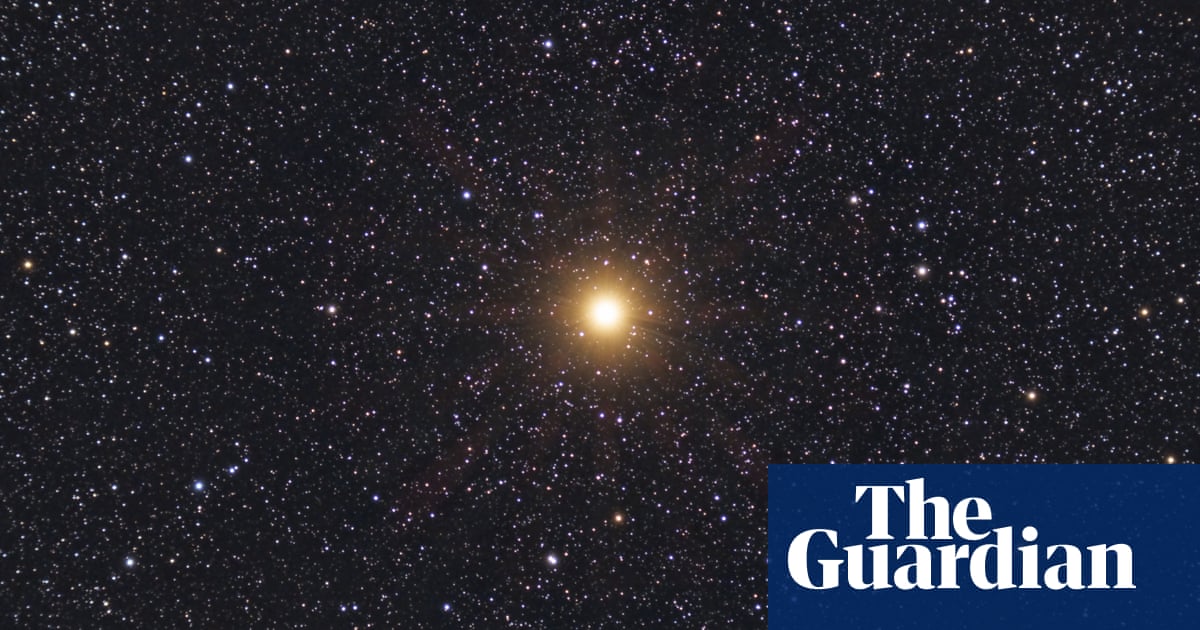
One of the brightest stars in the sky is behaving strangely, pulsating from bright to dim twice as fast as usual and giving scientists an unprecedented insight into how stars die.
Betelgeuse, the closest red giant to Earth, has long been understood to move between brighter and dimmer in 400-day cycles. But from late 2019 to early 2020, it underwent what astrophysicists called “the great dimming”, as a dust cloud obscured our view of the star.
Now, it is glowing at 150% of its normal brightness, and is cycling between brighter and dimmer at 200-day intervals – twice as fast as usual – according to astrophysicist Andrea Dupree of the Harvard-Smithsonian Centre for Astrophysics. It is currently the seventh brightest star in the night sky – up three places from its usual tenth brightest.
In the southern hemisphere sky it can be spotted glowing brightly in the early evening, at the shoulder of the Orion constellation. As days grow shorter in the northern hemisphere, it will be visible there too.
Betelgeuse is expected to explode some time in the next 10,000 to 100,000 years.
“One of the coolest things about Betelgeuse is that we’re watching the final stages of big star evolution play out almost in real time for us, which we’ve never really been able to study in this much depth before,” says Dr Sara Webb, an astrophysicist at Swinburne University of Technology in Australia.
Observing its behaviour gives important insights into the behaviour of red giants before supernova explosions. When it does eventually explode, it could – over the course of a week – grow so bright that it will be visible during daylight, and cast shadows at night.
There are records from ancient Egypt of what appears to be a star exploding as a supernova. The Egyptians described the appearance of a “second sun” in the sky, says Webb.
The great dimming was caused by the star spitting out a lump of gas and dust, like chewing gum: or what scientists call a “surface mass ejection” caused by an “anomalously hot convective plume”.
That lump was several times the mass of Earth’s moon, says Webb.
“If we were to throw one of our arms away from us, it changes the way our forces move in our body. And a similar thing happened with poor Betelguese,” says Webb.
“So it’s pushed all of this mass away and now its core and its stability are still trying to recover.”
The paper Dupree co-authored with other scientists from Harvard and the University of California, Berkeley, concludes that it will be five to 10 years before Betelgeuse returns to its normal 400-day cycles.
“Since the dimming, Betelgeuse’s light and radial velocity curves have been markedly different from its past,” the authors write.
“It’s new territory,” says Webb. “We haven’t seen this before.”
In Greek astronomy, Betelgeuse (pronounced “beetlejuice”, like the Tim Burton film character) marks one of the shoulders in the constellation Orion, but its name comes from the Arabic bat al-jawzāʾ, which means “the giant’s shoulder”.
Aboriginal Australians discovered the star’s bright and dim cycles long before western astronomers, who until 1596 believed that stars were “unchanging and unvariable”, according to the Conversation.
In the cosmology of the Kokatha Mula people in South Australia, Betelgeuse marks the right hand and fire magic of a hunter named Nyeeruna – this is the hunter’s fire magic, which he uses to try to overpower a protective older sister named Kambugudha. As the two figures battle, Nyeeruna’s fire magic grows brighter, dimmer and brighter again.
While Betelgeuse is very unlikely to explode in our lifetimes, “we don’t know”, says Webb. “I mean, I’ve always got all of my fingers and toes crossed that maybe we’ll get lucky.”
We’re also watching this in the past, she explains: the light from Betelgeuse is more than 600 years old.
“Theoretically it probably hasn’t, but theoretically it could have exploded and we wouldn’t know.”












